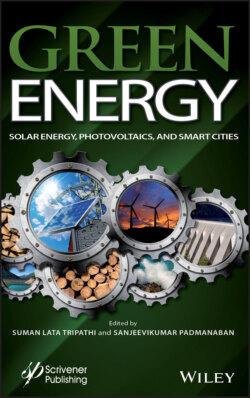Читать книгу Green Energy - Группа авторов - Страница 10
Оглавление
Preface
Green energy technology has not only given a concept of clean energy but also reduces dependency on fossil fuel for electricity generation through smart power electronics integration. Also, endless resources have more potential to cope with the requirements of smart building and smart city concept. The power electronics in a smart and intelligent approach can lead to highly efficient energy systems supporting the increasing demand for eco-friendly energy systems. The objective of this edition is to provide a broad view of the fundamental concepts and development process of green energy technology in a concise way for fast and easy understanding. This book provides information regarding almost all aspects to make it highly beneficial for all students, researchers and teachers of this field. Fundamental principles of green energy systems with AI and machine learning techniques are discussed herein in a clear and detailed manner with an explanatory diagram wherever necessary. The technological trends and latest developments based on green energy systems and applications are the major focus of the book. All the chapters are illustrated in simple language which will facilitate readability of the chapters.
Chapter Organization
This book is organized into 20 chapters.
Chapter 1 discusses the crystalline silicon solar cell (c-Si)–based technology that has been recognized as the environment-friendly viable solution to replace traditional energy sources for power generation. The chapter mainly elaborates the three basic c-Si solar cell configurations that are monofacial, bifacial and back-contacted solar cell configurations.
Chapter 2 is mainly focused on p-type mono-Si-PERC and n-type c-Si based TOPCon solar cell with enhanced efficiency. The use of HJ-TF cells, the Cu2O, InGaN, CuInS2, and InP fabrics are also explored for solar cell developments.
Chapter 3 summarizes the recent advancement made in the fabrication and manufacturing process for commercialization of PSC in the photovoltaic (PV) market and also various possible techniques used to improve their physical properties, and overcome hurdles and challenges while fabricating perovskite films.
Chapter 4 presents a short yet comprehensive survey on the metaheuristic approaches to the parameter assessment of solar photovoltaic systems modelled by different diode models.
Chapter 5 describes the review and challenge in solar PV cell design and implementation. Furthermore, it outlines the existing PV systems, the structure of different PV panels, MPPT, and the solid-state converter topologies.
Chapter 6 compares the developed method with its traditional counterpart, and the results of the experiment show that the new model performs better in terms of computational efficiency, compression gain, and SOH estimation accuracy.
Chapter 7 presents a detailed discussion on power quality (PQ) disturbances that cause rigorous issues in smart grids and industries. This mainly covers event-driven processing, analysis and machine learning for successful and efficient detection of PQ disturbances.
Chapter 8 is intended to provide information about the structural, optical, dielectric and conductivity with the help of compositional modification at Sr-site of Sr2SnO4 by homovalent (Ba2 +) and hetrovalent (La3 +).
Chapter 9 focuses on the detailed modelling of a solar photovoltaic (PV) panel. Here, a single-diode four-parameter model is also described that can be used for all panels in general.
Chapter 10 explores a stepped DC link converter for solar power that is focused for configurations of BCMLI, CDCLHBI and BCDCLHBI and synthesizing seven-level AC power output.
Chapter 11 derived a new modified double-diode model equation and on the basis of that formed a new objective function for MDDM. The HHO algorithm was used to estimate all the eight parameters of the system for different types of commercially available PV modules.
Chapter 12 describes a switched-inductor switched-capacitor-based large-gain DC-DC converter with low voltage stress on its switches/diodes.
Chapter 13 envisages presenting the stability concerns and issues associated with microgrids along with a state-of-the-art review of the techniques employed for improving stability of microgrids working in either islanded or grid-connected mode.
Chapter 14 deals with three-phase current ripples, and also the torque ripple of a surface-mounted permanent magnet synchronous motor (SPMSM) was completely analysed and minimized based on the variable switching frequency PWM (VSFPWM) method.
Chapter 15 discuss the implementation of Internet of Things (IoT) in the Smart Home, which plays a major role in making the things automatic and also saves a lot of energy.
Chapter 16 deals with the assessment of the economic and environmental impacts of energy conservation strategies in a university campus.
Chapter 17 suggests a novel double-source basic unit for cascaded MLIs that can produce seven output voltage steps with Trinary magnitude of DC supplies. The suggested structure can operate as symmetric or asymmetric MLI.
Chapter 18 presents the designing procedure of conventional and the vector control, Proportional Integral (PI) controller and analyzes the performance characteristics of DFIG connected to the Grid Systems.
Chapter 19 describes the combination of conventional SEPIC and quadratic boost converters with a boosting stage, which increases the boosting factor of converter. The continuous input-current as well as large boosting capability make the proposed topology applicable for Photovoltaic (PV) applications.
Chapter 20 proposes two novel basic configurations for switched-capacitor-based 13- and 17-level inverters, with high step-up capability and self-voltage balancing of capacitors.
